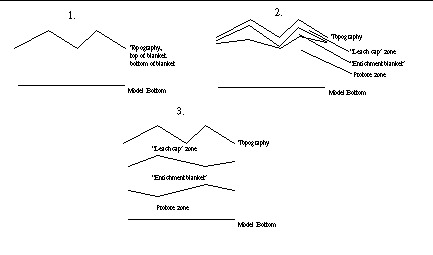Wes Bethel - ICSD/NERSC, Berkeley National Laboratory Karsten Pruess - ESD, Berkeley National Laboratory George Brimhall - Geophysics, UC Berkeley and ESD, Berkeley National Laboratory Tim Mote - Geophysics, UC Berkeley
Project Summary
Our work is motivated by the need for tools for visualizing "large" and hetereogeneous data.
Table Of Contents
The Original Proposal
Choose one of these formats:Work Plan and Priorities
The final funding amount covers 1/2 FTE for the visualization work only. The other portions of the proposed work, merging the hydro and chemical reactivity codes and porting to an MP architecture, were not funded as part of this LDRD. Given this funding level, overall project goals were refocused to fit the available funding.Modified Project Goals
- Visualization of Large Data
- Direct Volume Rendering of "Large" Data Sets
- Multiresolution Techniques
- Visualization Techniques for Heterogeneous Data
- Code Instrumentation
- Computational Framework for Surface Evolution Computation
- Scalar Workstation Version
- MPI-based Parallel Version
Results
-
- Visualization of Large Data
- Ever-increasing simulation resolution leads to larger and larger data set sizes. The capacity of conventional graphics workstations limits the size of data which can be effectively visualized. Two broad approaches were investigated for the purposes of addressing this problem.
-
- Software Direct Volume Rendering of "Large" Data Sets
- We developed an experimental technique for use in direct volume rendering of large data sets. The basic idea is to use the large aggregate memory size of a distributed memory architecture and lots of processors for direct volume rendering. More information is available here.
- Hardware Accelerated Volume Rendering combined with Subsetting
- Not ready yet.
- Multiresolution Techniques
- Not ready yet.
- Visualization Techniques for Multi-Source and Heterogeneous Data
- This page contains info about our efforts to visualize multisource data.
- Code Instrumentation.
- This page provides details of a tool which can be used to instrument code for the purposes of visualization. The tool implements a client-server model, using a socket-based TCP/IP streaming protocol. One advantage of this tool over others is that it can be implemented within any MP programming framework: it is not limited to PVM, MPI, etc. This tools was developed as part of a collaboration with a visiting physicist from Ohio State University, for he needed a tool that could be used to "get at" data within a simulation while it was running on a MPP machine (the T3E at NERSC).
- Computational Framework for Surface Evolution Computation
- Brimhall is modeling the evolution of mineral concentration over time using a first-principles approximation of mass balance. Referring to this figure:

The basic idea is that over time, as water enters the model from the top (rainfall), copper movement over time can be estimated using a first-principles estimate of mass balance. In other words, water enters the system, and displaces copper. The Brimhall/Pruess LDRD focuses on implementing a computational code which accurately captures the both the chemical reactions and physical transport of minerals in the system.
In this LDRD, we focus on the computation and visualization of the horizon evolution. The computation is of a vertically-evolving model, with overall goal of building a computational framework which can later be extended by the researchers to include a lateral displacement component.
There are three broad "zones" or classification regions within this model. In the early stages of the evolutionary process, the three regions are identical in depth, and as more water passes through the system, that the depth of the layers changes. This description captures only vertical movement of minerals. In reality, there is also lateral movement, and this lateral movement accounts for significant copper deposits in the alluvium surrounding the mountain.

- Scalar Workstation Version
- MPI-based Parallel Version
Downloadable Software
- Data Blaster code instrumentation package.
- Surface Fitter source code.